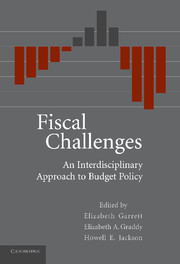Book contents
- Frontmatter
- Contents
- Preface
- Contributors
- PART ONE THE LAW AND POLITICS OF FISCAL POLICY
- PART TWO UNDERSTANDING FEDERAL DEFICITS AND PUBLIC DEBT
- PART THREE BUDGETING AND FISCAL CONSTRAINTS AT THE STATE LEVEL
- 8 Budgetary Arrangements in the 50 States: In Search of Model Practices
- 9 The Calculus of Constraint: A Critical Review of State Fiscal Institutions
- 10 When Does the Ballot Box Limit the Budget? Politics and Spending Limits in California, Colorado, Utah, and Washington
- Part Three Bibliography
- PART FOUR INTERGOVERNMENTAL ASPECTS OF BUDGET POLICY
- PART FIVE JUDICIAL POWERS AND BUDGET POLICY
- Index
9 - The Calculus of Constraint: A Critical Review of State Fiscal Institutions
Published online by Cambridge University Press: 23 December 2009
- Frontmatter
- Contents
- Preface
- Contributors
- PART ONE THE LAW AND POLITICS OF FISCAL POLICY
- PART TWO UNDERSTANDING FEDERAL DEFICITS AND PUBLIC DEBT
- PART THREE BUDGETING AND FISCAL CONSTRAINTS AT THE STATE LEVEL
- 8 Budgetary Arrangements in the 50 States: In Search of Model Practices
- 9 The Calculus of Constraint: A Critical Review of State Fiscal Institutions
- 10 When Does the Ballot Box Limit the Budget? Politics and Spending Limits in California, Colorado, Utah, and Washington
- Part Three Bibliography
- PART FOUR INTERGOVERNMENTAL ASPECTS OF BUDGET POLICY
- PART FIVE JUDICIAL POWERS AND BUDGET POLICY
- Index
Summary
Recent state fiscal crises have renewed academic and policy interest in institutions designed to limit the size or growth of government. Examples include tax and expenditure limits, balanced-budget rules, the executive line-item veto, and debt restrictions. This chapter provides a critical review of these fiscal institutions and their effectiveness, drawing on recent empirical research and highlighting unresolved questions in the literature. In particular, the chapter explores how fiscal institutions fit within dominant models of political economy, including the median-voter model and Leviathan view of government. The chapter concludes by offering an alternative contracting perspective and drawing testable propositions for future work.
INTRODUCTION
Recent years have been tumultuous for state government finances. A mild national recession in the early 1990s was felt strongly in certain states, prompting substantial tax hikes, spending cuts, and a depletion of fund balances. State revenues rebounded dramatically in the late 1990s, buoyed by income from the realization of capital gains and the exercise of stock options. These revenues fueled additional spending on politically popular areas such as education, health care, and tax relief.
This fiscal boom, however, was short-lived. Stock market declines in 2001 together with worsening economic conditions and a reluctance to take corrective actions generated widening gaps between projected revenues and expenditures. At the start of fiscal year 2004, states faced a combined gap of more than $78 billion. In 37 states, projected budget shortfalls were equivalent to at least 5 percent of total spending.
- Type
- Chapter
- Information
- Fiscal ChallengesAn Interdisciplinary Approach to Budget Policy, pp. 271 - 289Publisher: Cambridge University PressPrint publication year: 2008
- 2
- Cited by



